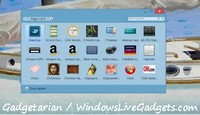How to select and manage your fonts, with Font Xplorer
Basics
When you run Font Xplorer, you’ll see a list of fonts that are installed (actually loaded) in your system. Each font is drawn with its own face so you can very easily choose the best font for your task. That way, you’ll have a complete overview of fonts available in your system or in a disk folder. You can change the size of the fonts displayed (View -> Font Size), toggle the display of font names (View -> Font names),or only display fonts that have a specific character set (Filter -> Character Set) etc. This last mode is very useful if you want to see only symbol fonts for example, or all fonts that contain cyrillic characters…
Sometimes you may want to compare your own text string drawn with different fonts so that you can choose the perfect one for a specific task. See the User Text Mode for more info.
Also, you may find it useful to browse fonts from certain a folder directly, instead of seeing only loaded fonts. See the Folder Browser mode.
By right-clicking on the font list, the font context-menu is displayed. This menu contains some extremely useful commands that allow you to manipulate selected font(s) . Try right-clicking any object since many objects have a special context-menu that lists commands available for that object.
To refresh the font listing use the Refresh command in the View menu.
Moving Around
You can navigate through the list of fonts with the arrow keys. This is an ordinary Windows list box where up and down arrows move to the previous/next font. Home moves to the top and End moves to the end of the listing. In addition, if you want to jump directly to a font that starts with a specified letter, just press that character key on the keyboard. Press it again and the next font that starts with this character will be selected. For example if you are on the top of the list, but want to jump to fonts whose name starts with T, just press the T key on keyboard and your are there.
To find the previous/next checked font use Ctrl+Up / Down
To scroll a whole page at a time use Page Up/Page Down
For fast scrolling, you can hold down the Ctrl key when dragging the scroll bar. Fonts will then not be drawn on the list during scrolling; instead, you’ll see a tooltip with the current topmost font name.
